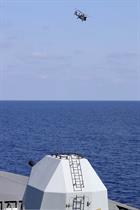Royal Navy’s newest helicopter lands on HMS Daring
One of the Royal Navy’s newest helicopters has landed on the flight deck of HMS Daring for its first operational deployment on a Type 45 destroyer in the Gulf.
The Wildcat, of Yeovilton-based 204 Flight, 825 Naval Air Squadron, is one of the latest generation of multi-role helicopters specifically procured to operate from the Royal Navy’s frigates and destroyers.
It joins Daring for her nine-month deployment to the Middle East, making it the first Wildcat to deploy for a full operational tour east of Suez on one of the Daring-class destroyers.
“These are exciting times for the Fleet Air Arm, and for us on board as Daring’s embarked flight, as we prepare this brand new aircraft in the early stages of its service with the Royal Navy,” said Lieutenant Andrew Henderson, 35, from Bath, who is the ship’s flight commander and one of the Royal Navy’s most seasoned Wildcat operators.
“The Wildcat may look like a Lynx Mk8, but it offers so much more. The one we’re flying off the back of HMS Daring is only a year old and we’re still learning about all the things it can do. We are in a privileged position to be here in the formative early period of the Wildcat’s service and the work we do on this deployment will have a positive effect on the way the aircraft is used for years to come.”
While it looks a lot like its predecessor, the Lynx Mk8, and possesses many of its outstanding characteristics, the Wildcat is a significant upgrade in many ways and packs an extra punch.
The Wildcat’s engines are considerably more powerful than its predecessor, providing much-improved performance when operating in hot environments and at high altitudes – a vital asset in the face of the punishing temperatures found in the Middle East.
A completely redesigned tail, which is the greatest visual difference between old and new, also allows for a more powerful tail rotor system, as well as improving the aircraft’s strength and stealth qualities.
Aircrew also enjoy a much-improved cabin, from state-of-the-art cockpit instruments, hi-tech communications to crash-worthy armoured seats which drastically enhance survivability in the event of a crash landing.
Cutting-edge targeting systems and a 360° full-colour surveillance radar help crew pick out their prey and, if necessary, engage them.
“It’s a real privilege to be able to fly the Wildcat from HMS Daring on a deployment which is the first of its kind in so many ways,” said 32-year-old pilot Lieutenant Dal Nwokora, from Bradford-upon-Avon.
“The Wildcat brings a hugely improved capability to the ship over what the Lynx offered – and the Lynx offered a lot. This deployment has been a great experience for me so far and is something I have been looking forward to as the culmination of years of training.”
The Wildcat’s first job as Daring’s embarked flight was to salute the families of those on board who gathered in Portsmouth in September to wave off their loved ones. The aircraft surprised the waiting crowds on the city’s seafront with a flypast before later joining the ship at sea.
Wildcat will, like its predecessor, be earmarked for a variety of roles – anti-ship, anti-submarine, ship protection, casualty evacuation, battlefield reconnaissance and general utility, but it will bear the suffix HMA, which stands for ‘Helicopter Maritime Attack’.
“One of the important things we will be doing on this deployment is educating the ship about just what the Wildcat can offer,” said flight observer Lt Kev Regan, 37, of Liverpool.
“Because it looks like a Lynx Mk8 people assume it offers the same capability. It actually offers a lot more and we are looking forward to demonstrating just what this new aircraft is capable of.”
As part of their deployment, the flight crew on board HMS Daring welcomed on board Commander Simon Collins, the Commanding Officer of 825 NAS, to witness this significant milestone in the squadron’s history.
HMS Daring sailed from Portsmouth on 2 September for a nine-month mission in the Middle East.
The Type 45 destroyer and her 250-strong crew, including the embarked Royal Marines boarding team and flight, are preparing for their task to use the ship’s sophisticated radar and missile systems to protect allied warships and international merchant shipping through the Gulf of Aden and surrounding seas.
The nine-month deployment follows that of her sister ship HMS Defender, which carried out a similar role earlier this year.






